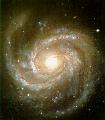INGRID is the new near-infrared camera
for the William Herschel Telescope. This device will be the default detector for the
state-of-art adaptive optics NAOMI instrument expected to be commissioned
next summer. INGRID which will see first light next 16 March. The following
is a list of tentative first light objects:
 . Orion Nebula (M42 or NGC
1976). This is a star-forming region. The gas and dust in the nebula
emits light because it is irradiated by nearby emerging stars. Shown here are 10s exposure
true-colour pictures using BVR imaging on the new WHT prime focus camera.
. Orion Nebula (M42 or NGC
1976). This is a star-forming region. The gas and dust in the nebula
emits light because it is irradiated by nearby emerging stars. Shown here are 10s exposure
true-colour pictures using BVR imaging on the new WHT prime focus camera.
 . M67 Open Star
Cluster. M67 is one of the oldest known open clusters, being
aged at 3.2 billion years. It has been calculated that
M67 can expect to exist as a cluster for about another 5 billion years.
The total number of stars in M67 is probably at least about 500.
. M67 Open Star
Cluster. M67 is one of the oldest known open clusters, being
aged at 3.2 billion years. It has been calculated that
M67 can expect to exist as a cluster for about another 5 billion years.
The total number of stars in M67 is probably at least about 500.
 . M87 Galaxy. The giant elliptical galaxy
M87, also called Virgo A, is one of the
most remarkable objects in the sky. It is perhaps the dominant
galaxy in the closest big cluster to us, the famous Virgo Cluster
of galaxies (sometimes also called "Coma-Virgo cluster" which
is more acurate, as it extends into constellation Coma), and lies
at the distance of this cluster (about 60 million light-years). M87
lies well in the heart of the Virgo cluster. It contains much more stars
(and mass) than our galaxy, certainly several trillion (10^12) solar masses.
M87 is famous for two peculiar and perhaps unique features, a huge globular
cluster system found on
long exposures, and a spectacular jet which is better seen on
short exposure photographs.
. M87 Galaxy. The giant elliptical galaxy
M87, also called Virgo A, is one of the
most remarkable objects in the sky. It is perhaps the dominant
galaxy in the closest big cluster to us, the famous Virgo Cluster
of galaxies (sometimes also called "Coma-Virgo cluster" which
is more acurate, as it extends into constellation Coma), and lies
at the distance of this cluster (about 60 million light-years). M87
lies well in the heart of the Virgo cluster. It contains much more stars
(and mass) than our galaxy, certainly several trillion (10^12) solar masses.
M87 is famous for two peculiar and perhaps unique features, a huge globular
cluster system found on
long exposures, and a spectacular jet which is better seen on
short exposure photographs.
 .
M100 Galaxy. The galaxy M100 is one of the brightest members of the
Virgo Cluster of galaxies. M100 is spiral shaped, like our Milky Way, and tilted
nearly face-on as seen from earth. The galaxy has two prominent
arms of bright blue stars and several fainter arms. The blue stars
in the arms are young hot and massive stars which formed
recently from density perturbations caused by interactions with
neighboring galaxies. Shown on the left is a true colour image obtained using BVI CCD imaging on the INT. New infrared and optical
images taken with the WHT suggest that this "normal" spiral galaxy hides a barlike
structure in its heart.
.
M100 Galaxy. The galaxy M100 is one of the brightest members of the
Virgo Cluster of galaxies. M100 is spiral shaped, like our Milky Way, and tilted
nearly face-on as seen from earth. The galaxy has two prominent
arms of bright blue stars and several fainter arms. The blue stars
in the arms are young hot and massive stars which formed
recently from density perturbations caused by interactions with
neighboring galaxies. Shown on the left is a true colour image obtained using BVI CCD imaging on the INT. New infrared and optical
images taken with the WHT suggest that this "normal" spiral galaxy hides a barlike
structure in its heart.
 . The Sombrero Galaxy (M104
Galaxy). This brilliant galaxy was named the Sombrero Galaxy because of its
appearance. According to de
Vaucouleurs, we view it from just 6 degrees south of its equatorial plane,
which is outlined by a rather
thick dark rim of obscuring dust. This dust lane was probably the first
discovered, by William
Herschel in his great reflector. This galaxy is of type Sa-Sb, with both a big bright core, and also well-defined spiral arms. It also has an unusually pronounced bulge
with an extended and richly
populated globular cluster system.
This galaxy was the first one with a large redshift found, by V.M. Slipher
at Lowell Observatory in
1912. Its redshift corresponds to a recession velocity of about 1,000 km/sec.
. The Sombrero Galaxy (M104
Galaxy). This brilliant galaxy was named the Sombrero Galaxy because of its
appearance. According to de
Vaucouleurs, we view it from just 6 degrees south of its equatorial plane,
which is outlined by a rather
thick dark rim of obscuring dust. This dust lane was probably the first
discovered, by William
Herschel in his great reflector. This galaxy is of type Sa-Sb, with both a big bright core, and also well-defined spiral arms. It also has an unusually pronounced bulge
with an extended and richly
populated globular cluster system.
This galaxy was the first one with a large redshift found, by V.M. Slipher
at Lowell Observatory in
1912. Its redshift corresponds to a recession velocity of about 1,000 km/sec.

